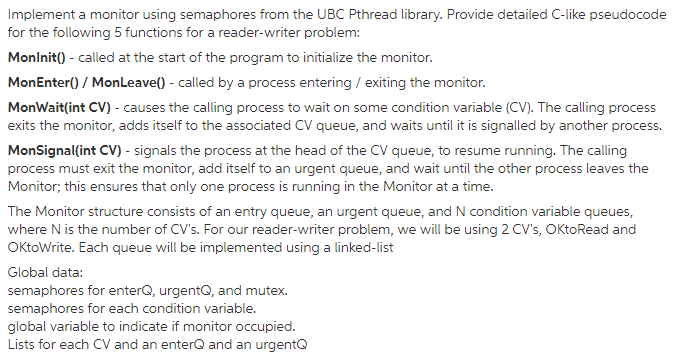
Implement a monitor using semaphores from the UBC Pthread library. Provide detailed C-like pseudocode for the following 5 functions for a reader-writer problem: Monlnit0 - called at the start of the program to initialize the monitor MonEnter0/MonLeave called by a process entering/exiting the monitor MonWait(int CV) - causes the caling process to wait on some condition variable (CV). The calling process exits the monitor, adds itself to the associated CV queue, and waits until it is signalled by another process. MonSignal(int CV) - signals the process at the head of the CV queue, to resume running. The calling process must exit the monitor, add itself to an urgent queue, and wait until the other process leaves the Monitor; this ensures that only one process is running in the Monitor at a time The Monitor structure consists of an entry queue, an urgent queue, and N condition variable queues, where N is the number of CV's. For our reader-writer problem, we will be using 2 CV's, OKtoRead and OKtoWrite. Each queue will be implemented using a linked-list Global data semaphores for enterQ, urgentQ, and mutex. semaphores for each condition variable global variable to indicate if monitor occupied. Lists for each CV and an enterQ and an urgentQ Implement a monitor using semaphores from the UBC Pthread library. Provide detailed C-like pseudocode for the following 5 functions for a reader-writer problem: Monlnit0 - called at the start of the program to initialize the monitor MonEnter0/MonLeave called by a process entering/exiting the monitor MonWait(int CV) - causes the caling process to wait on some condition variable (CV). The calling process exits the monitor, adds itself to the associated CV queue, and waits until it is signalled by another process. MonSignal(int CV) - signals the process at the head of the CV queue, to resume running. The calling process must exit the monitor, add itself to an urgent queue, and wait until the other process leaves the Monitor; this ensures that only one process is running in the Monitor at a time The Monitor structure consists of an entry queue, an urgent queue, and N condition variable queues, where N is the number of CV's. For our reader-writer problem, we will be using 2 CV's, OKtoRead and OKtoWrite. Each queue will be implemented using a linked-list Global data semaphores for enterQ, urgentQ, and mutex. semaphores for each condition variable global variable to indicate if monitor occupied. Lists for each CV and an enterQ and an urgent







